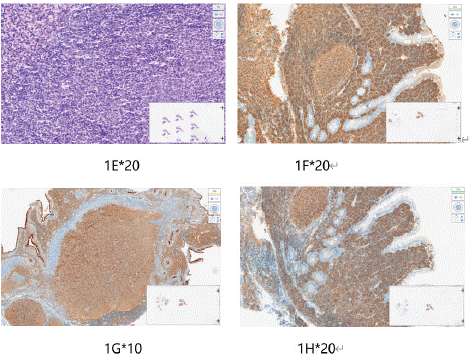
Special Article: Endoscopic Surgery
Austin J Surg. 2024; 11(3): 1328.
A Case of Duodenal-type Follicular Lymphoma
Ximei Ren¹; Qibin He¹*; Guifang Xu²*
¹Department of Gastroenterology, The Affiliated Jiangning Hospital of Nanjing Medical University, China
²The Affiliated Drum Tower Hospital of Nanjing University Medical School, China
*Corresponding author: Qibin He, Department of Gastroenterology, The Affiliated Jiangning Hospital of Nanjing Medical University, Nanjing 211100, China; Guifang Xu, The Affiliated Drum Tower Hospital of Nanjing University Medical School, NO. 321 Zhongshan Road, Nanjing 210008, Jiangsu, China.Tel: +86-25-83105206; Fax: +86-25-83105206 Email: 496616814@qq.com; xuguifang@njglyy.com
Received: July 31, 2024 Accepted: August 23, 2024 Published: August 30, 2024
Case Presentation
A 47-year-old female patient underwent esophagogastroduodenoscopy because of intermittent abdominal pain for more than 10 years. The patient has a history of hepatitis B. No obvious abnormality was found in physical examination and laboratory examination. Gastroscopy revealed multiple small white nodular lesions in the descending part of the duodenum, with no apparent abnormalities of the nipple. The mucousa of the frenulum proliferates, and there is a depression in the center of it. Mucosa in the depression showed fading tone, and mucosa in the protuberance showed red color. Magnifying endoscopy with indigo-carmine staining confirmed the continued existence of the boundary. The ultrasound microprobe scan observed that the lesion was originated from the mucousal layer with irregular, uneven echo, but the submucosa was intact (Figure 1A, B, C & D). Histopathological examination showed chronic inactive enteritis with significant lymphoid hyperplasia (Figure 1E). Immunohistochemical analysis confirmed that CD20 (Figure 1F), CD10 (Figure 1G) and BCL2 (Figure 1H) were strongly positive, which was consistent with Follicular Lymphoma (FL). Bone marrow biopsy and abdomen enhanced CT excluded extraintestinal involvement. Consequently, based on those findings, the patient was diagnosed as duodenal follicular lymphoma, despite the absence of obvious symptoms. The patient was managed using the Watch-and-Wait (WW) strategy and underwent regular esophagogastroduodenoscopy approximately every six months at our institution. Duodenal-Type Follicular Lymphoma (DFL) is a unique and rare subtype of Follicular Lymphoma (FL). It is classified as a special subtype of FL in the wHO classification of lymphoid and hematopoietic tissue tumors (version 2016) [1]. There was abnormal expression of CD10, CD20 and Bcl.2 in the second part of duodenum (descending part), and the proportion of male and female was equal. DFL patients have almost no clinical symptoms, the vast majority of patients are in the early stage of the disease in the fashion of diagnosis, and the prognosis is good, so most doctors choose the strategy of watching and waiting in the face of DFL patients(W&W) [2].

Figure 1:
Author Statements
Ethics
This retrospective review of patient data did not require ethical approval in accordance with national guidelines. Written informed consent from participants was not required in accordance with national guidelines.
Funding Sources
This work was supported by grants from the National Natural Science Foundation of China (Grant Nos. 81572338 and 81672380, 81201909, 81602089), the Nanjing Medical Science and Technology Development Program (Nos. YKK15061 and YKK16078). This work was also part of a C-class sponsored research project of the Jiangsu Provincial Six Talent Peaks (WSN-078).
Conflict of Interest Statement
Drs. Ximei Ren, Qibin He, Guifang Xu, have no conflicts of interest or financial ties to disclose.
Author Contributions
Ximei Ren: Conceptualization, Writing- Original draft preparation. Guifang Xu: Writing- Reviewing and Editing, Funding acquisition. Qibin He: Project administration, Supervision.
Data Availability Statements
All data generated or analyzed during this study are included in this article and its supplementary material files. Further enquiries can be directed to the corresponding author.
References
- Kurz KS, Kalmbach S, Ott M, Staiger AM, Ott G, Horn H, et al. Follicular Lymphoma in the 5th Edition of the WHO-Classification of Haematolymphoid Neoplasms-Updated Classification and New Biological Data. Cancers (Basel). 2023; 15: 785.
- Marks E, Shi Y. Duodenal-Type Follicular Lymphoma: A Clinicopathologic Review. Arch Pathol Lab Med. 2018; 142: 542-547.